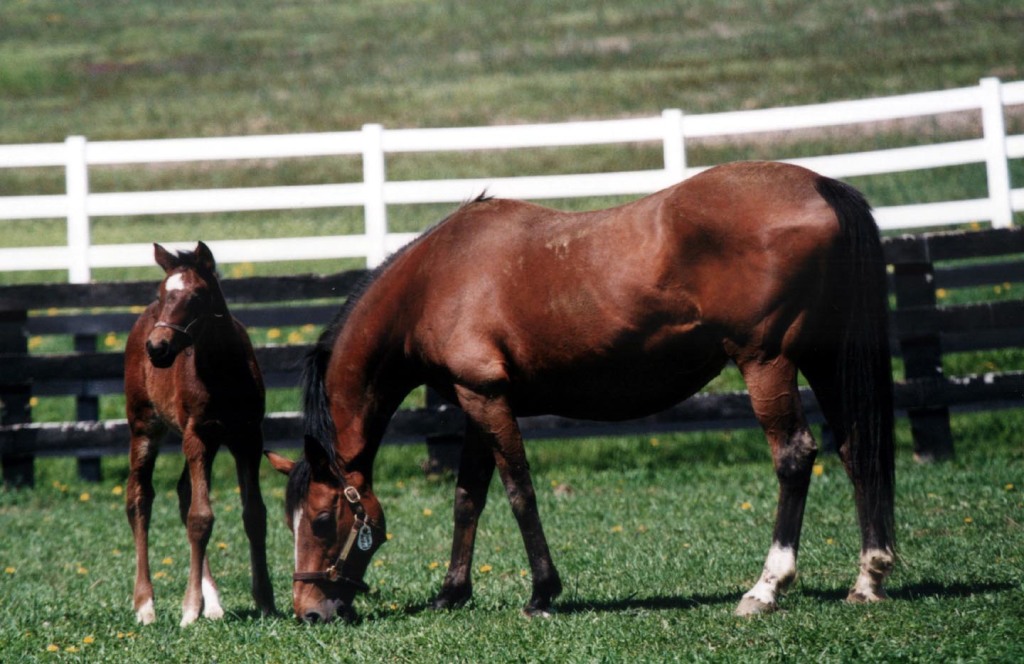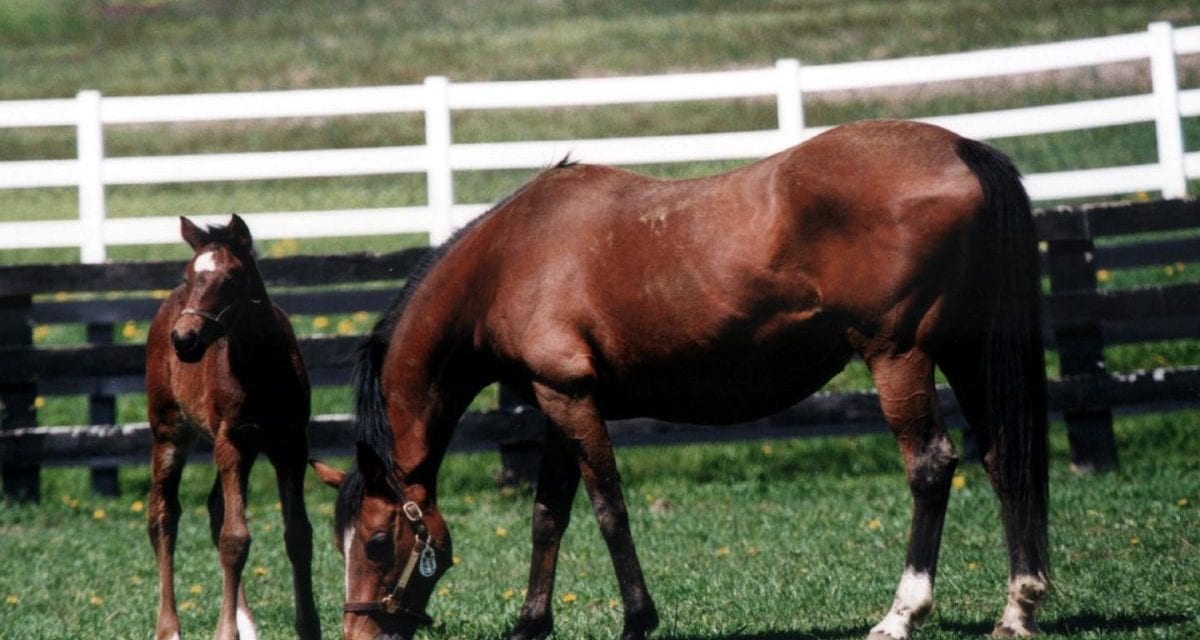
Photo by Laurie Asseo.
by Linda Dougherty
While the 2015 Report of Mares Bred released by The Jockey Club in late October showed that there has been a steadily declining number of mares bred in the mid-Atlantic region over the last five years, it also reflects an ongoing trend that a great percentage of those mares seem to “follow the money.”
The report, published each year about this time, captures more than 90 percent of mares bred, says the Jockey Club. It differs from state-bred registries in that it accounts for mares bred to stallions standing in a given state. The resultant foals, of course, may be born anywhere, though the lion’s share of mares bred to mid-Atlantic stallions will foal in the region, most often in the state in which the breeding occurred.
When deciding where to breed their mares and drop the foals, mare owners typically look ahead three years, to the time that the resulting foal is old enough to race and begin generating purses and breeders’ awards. While nearly all states in the mid-Atlantic region have slots-enriched breeding programs except New Jersey, several of them have been under duress from their legislators, making the ongoing viability of each program continually in question.
The annual threat by legislators in Harrisburg to raid Pennsylvania’s Race Horse Development Fund (RHDF), which fuels purses and breeding incentives, for example, as well as a recent reduction in race dates at Parx Racing, have contributed to uncertainty there, causing the number of mares bred to Pennsylvania stallions drop off by more than half since 2011. Many of those mares had come to Pennsylvania from Maryland to take advantage of the newly-enriched breeding program.
But as Maryland’s racing and breeding fortunes improved over the last five years, with casinos revenue starting to infuse its racing and breeding industries, and race dates increasing, new stallions arrived — and those same mares came back.
In 2011, there were 548 mares bred to Maryland stallions, while just across the border in Pennsylvania there were 1,313 mares bred, according to The Jockey Club.
This year, the number of mares bred in Maryland increased to 788, while it sharply declined to 627 mares in the Keystone State.
According to The Jockey Club, it was the fourth year in a row the number of mares bred to Maryland stallions increased, and the sixth year in a row the number of mares bred to Pennsylvania’s decreased. It also marked the first time since 2007 that Maryland stallions bred more mares than did Pennsylvania stallions.
The number of mares bred in Pennsylvania started to decline in 2010, when former Gov. Ed Rendell’s final budget called for the first diversion of money from the RHDF. Since 2010, more than $212 million has been diverted from the RHDF, with more than $185 million going to the state’s general fund budget, according to the state’s Auditor General.
“The political climate has a big impact on people’s breeding decisions,” said Cricket Goodall, executive director of the Maryland Horse Breeders Association. “People do not like uncertainty – hence the decline in Pennsylvania’s numbers. Perception becomes reality. That being said, Maryland has a firm infrastructure that was able to withstand the downturn in the industry successfully.”
Dr. William Solomon, who has stood stallions at his Pin Oak Lane Farm in New Freedom, Pa. for more than four decades, said several factors are to blame for the decline of mares bred in Pennsylvania.
“When slots were legalized, there was a huge surge in mares being bred in the state,” said Solomon. “But now there’s been a precipitous drop because the incentives breeders thought would be available, like restricted races and Pennsylvania-sired races, aren’t there. You get the annual threat of Harrisburg taking money away, and the general downturn in the breeding industry, and it all plays together.”
Solomon said that, despite more money being available in the Pennsylvania program, ultimately more of the Maryland program’s money gets returned to breeders and to restricted races and stakes, while Pennsylvania’s is carved up into three slices – for owners (a bonus of 40 percent of the purse is offered for the first three finishers in open races at Parx Racing, for example), breeders and restricted races.
He believes that if a bill currently under consideration in the legislature (Senate Bill 352) is modified to distribute more money to Pennsylvania-sired horses, it would immediately make an impact and spur greater interest in the breeding program, but he believes there’s little appetite to pursue that.
New Jersey’s number of mares bred has dropped from 148 in 2011 to only 38 in 2015, primarily because the Garden State’s racing and breeding programs do not enjoy added revenue from expanded gaming, putting them at a competitive disadvantage.
“I know breeders have moved their mares from New Jersey to Pennsylvania, Maryland and New York,” said Michael Campbell, executive director of the Thoroughbred Breeders’ Association of New Jersey. “In speaking with those breeders, who also own farms in New Jersey, they would love to stay and support the breeding program, but the other states have more racing days and increased incentive award programs from VLTs or casinos.
“I believe when things turn around in New Jersey, breeders will return,” continued Campbell. “In the meantime, breeders that bred to better stallions and foaled in New Jersey are seeing great returns despite the shortened racing season. The leading breeder in New Jersey this year earned over $83,000 in incentive awards. The second and third highest earners in breeder awards both earned over $60,000. These awards were earned during 68 days of racing. So I think the program is successful despite the competition and shortened racing season, and am confident things will improve.”
Overall, there were 3,195 mares bred to stallions in the mid-Atlantic region (including Virginia and West Virginia) in 2010, a number that dropped to 2,268 in 2014. Those states have reported 1,978 to date in 2015. That’s a 29 percent drop from 2010 to 2014; nationally, the number of mares bred fell 17.5 percent in that same timeframe.
In 2011, the greatest number of mares in the region were bred in Pennsylvania (1,313) with West Virginia following with 759 and Maryland with 548.
The numbers shifted greatly by 2015, with Maryland leading the way with 788 mares bred, followed by Pennsylvania’s 627 and West Virginia dropping to 563 as the West Virginia racing and breeding programs came under attack from its state legislature. Many people have simply decided to get out of the breeding game altogether, also causing the number of mares bred in the region to drop by 793 in four years. Virginia’s foal crop was impacted by the lack of a racing circuit.
“The thoroughbred industry as a whole is still contracting, and that will continue to impact the numbers, both regionally and nationally, until the supply and demand of racing/commercial markets realign,” said Goodall.
STATE | 2015 | 2014 | 2013 | 2012 | 2011 | 2010 |
|---|---|---|---|---|---|---|
| MARYLAND | 788 | 732 | 643 | 582 | 548 | 577 |
| NEW JERSEY | 38 | 43 | 71 | 113 | 148 | 159 |
| PENNSYLVANIA | 627 | 812 | 971 | 1118 | 1313 | 1650 |
| VIRGINIA | 31 | 29 | 57 | 55 | 72 | 87 |
| WEST VIRGINIA | 563 | 652 | 724 | 704 | 759 | 722 |








